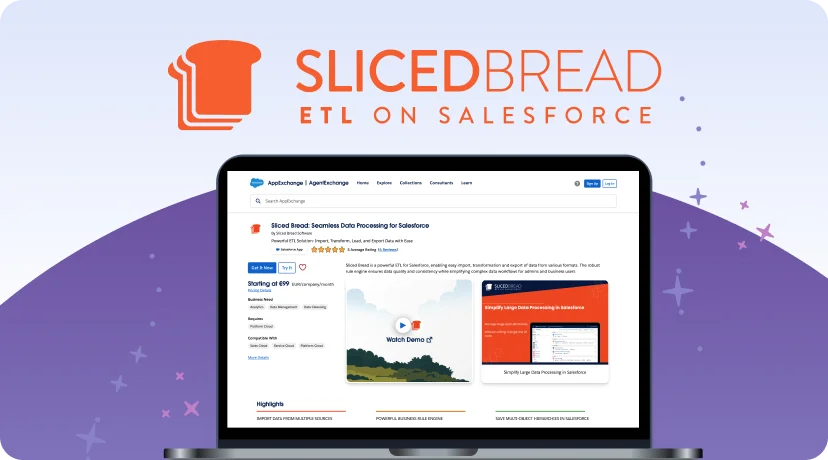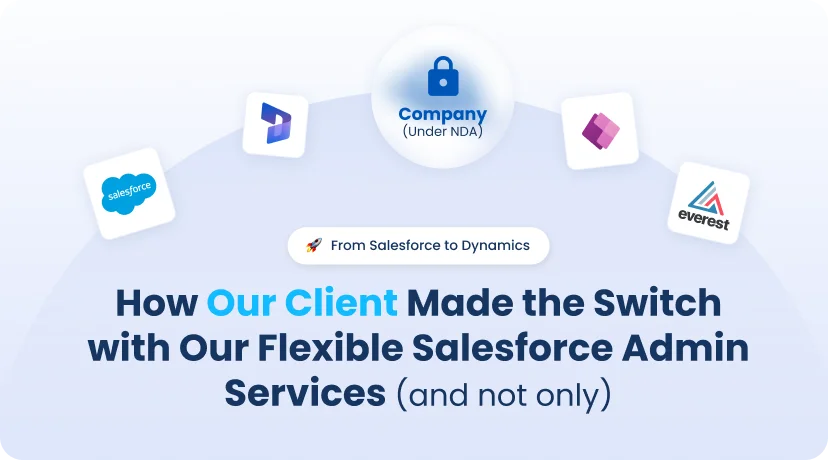
Salesforce outsourcing has emerged as a strategic imperative for enterprises seeking to optimize performance across customer relationship management (CRM), automation, and analytics functions. In an increasingly digital business landscape, outsourcing Salesforce projects enables organizations to align more closely with agility goals, access specialized skills, and reduce internal delivery bottlenecks.
The global outsourcing services market is projected to reach $854.6 billion this year, reflecting the growing reliance of enterprises on external partners to deliver complex digital transformation initiatives. Within this landscape, Salesforce services command a significant share, with the Salesforce services market estimated at $14.61 billion this year, growing at a compound annual growth rate (CAGR) of 15.4%.
More specifically, Salesforce consulting services, a crucial subset involving technical, strategic, and implementation support, are forecasted to reach $20.93 billion by this year. This expansion is fueled by enterprise demand for tailored CRM ecosystems, seamless third-party integrations, and scalable development frameworks.
Salesforce outsourcing refers to the practice of delegating Salesforce-related development, administration (read how to outsource Salesforce administration in particular), or implementation tasks to third-party vendors, typically Salesforce-certified partners, either onshore, nearshore, or offshore. These services range from CRM platform configuration and code development to end-to-end deployment and ongoing support.
The appeal of Salesforce jobs outsourcing stems from three primary advantages. First, it enables organizations to achieve cost savings of up to 70% compared to in-house operations. Second, it allows access to domain-specific expertise not always available locally. Third, it accelerates project delivery by leveraging globally distributed agile teams.
As Salesforce continues to evolve with AI integration, industry cloud solutions, and hyper-personalization tools, enterprises will increasingly require flexible, responsive service delivery models. Outsourcing Salesforce projects, when strategically executed, offers a scalable and economically viable path to innovation and operational excellence.
- Understanding Salesforce Outsourcing Models
- Salesforce Outsource: Types of Projects to Outsource to a Professional Team
- When to Outsource Salesforce Projects
- When Not to Outsource Salesforce Projects
- Checklist for Successful Salesforce Outsourcing Projects
- How to Choose Your Salesforce Outsourcing Service Provider
- FAQ
- What are the typical cost savings from Salesforce outsourcing?
- How long does it take to implement an outsourced Salesforce project?
- What are the primary challenges associated with outsourcing Salesforce projects?
- Is data security compromised when outsourcing Salesforce services?
- Can long-term support be outsourced, or is outsourcing suitable only for project-based work?
Understanding Salesforce Outsourcing Models
Salesforce outsourcing services are delivered through a range of geographic engagement models, each offering distinct benefits, limitations, and strategic implications. The three dominant approaches, offshore, nearshore, and onshore, vary by vendor location, time zone alignment, cultural compatibility, and overall cost-efficiency.
Insight:
Enterprises that define structured delivery KPIs and integrate vendor governance into broader IT management frameworks report higher project success rates and faster time-to-value from outsourced Salesforce implementations.
Offshore Outsourcing
Offshore Salesforce outsourcing refers to engaging service providers located in distant geographies, typically with a time zone difference exceeding five hours from the client’s base of operations. Popular offshore destinations include India, the Philippines, and Eastern Europe. This model is most frequently adopted for its substantial cost advantages. Organizations outsourcing Salesforce development offshore may achieve cost reductions of 50–70% compared to maintaining equivalent in-house teams.
However, these financial benefits may come with trade-offs. Time zone mismatches can extend decision cycles, and communication gaps may emerge without strong project governance. Moreover, offshore collaboration requires rigorous documentation, asynchronous workflows, and culturally adaptive communication to maintain delivery quality.
Nearshore Outsourcing
Nearshore outsourcing involves contracting Salesforce outsourcing services to providers in adjacent or neighboring countries, generally within two to four time zones. For example, a company based in Germany may nearshore development to Poland or the Czech Republic. This model combines several advantages of offshore arrangements, such as lower operational costs and a competitive talent pool, with improved real-time collaboration and cultural proximity.
The nearshore approach also enables more frequent client-vendor interactions, including hybrid project governance models with partial on-site involvement. As a result, nearshoring is increasingly favored by enterprises aiming to strike a balance between cost control and operational fluidity.
Onshore Outsourcing
Onshore outsourcing keeps Salesforce development and support within the same country as the client organization. Although onshore providers typically command premium billing rates, such as Salesforce developer salaries in the U.S. averaging over $115,000, this model enables maximum alignment in terms of legal frameworks, cultural understanding, and real-time responsiveness.
Onshore delivery is often selected for high-stakes Salesforce projects involving regulatory compliance, sensitive customer data, or deeply embedded workflows that necessitate close and ongoing collaboration between internal stakeholders and vendor teams.
Ultimately, selecting the appropriate Salesforce outsourcing model depends on a comprehensive assessment of project urgency, budget flexibility, compliance requirements, and operational readiness for remote delivery management.
Salesforce Outsource: Types of Projects to Outsource to a Professional Team
Salesforce development outsourcing encompasses a wide array of technical and strategic initiatives that enterprises commonly delegate to external partners. This approach enables organizations to scale capabilities quickly, leverage specialized expertise, and reduce overhead costs associated with in-house staffing. The types of outsourced Salesforce projects vary by scope, complexity, and functional focus but tend to cluster around key areas of platform configuration, integration, customization, and expansion.
The table below outlines the most frequently outsourced Salesforce project types, accompanied by descriptions and the primary rationale behind choosing external delivery teams.
| Project Type | Description | Reason for Outsourcing |
| CRM Customization | Tailoring Salesforce objects, fields, page layouts, and workflows | Requires platform-specific knowledge and rapid iteration |
| AppExchange App Development | Building custom apps for internal use or AppExchange distribution | Demands certified Salesforce developers and ISV program knowledge |
| Data Migration | Transferring large datasets from legacy systems or third-party CRMs | Requires data cleansing, deduplication, and validation expertise |
| Third-Party Integration | Connecting Salesforce with ERP, marketing, or finance systems | Involves cross-platform API fluency and middleware configuration |
| Salesforce CPQ Implementation | Configuring complex pricing and quote automation using Salesforce CPQ | Highly specialized skill set often not available in-house |
| Lightning Web Components (LWC) | Developing modern UI components using Salesforce’s proprietary framework | Requires up-to-date development skills and performance optimization |
| Salesforce Health Cloud Setup | Deploying vertical cloud solutions for healthcare and patient management | Involves domain knowledge and compliance-driven configuration |
| Ongoing Maintenance & Support | Providing Tier 2/3 support, upgrades, and enhancements | Enables cost-effective SLA-based managed services |
This table demonstrates the breadth of functions that can be successfully delivered by outsourced Salesforce teams. In particular, CRM customization and third-party integrations remain the most commonly assigned due to their high impact on usability and business process continuity.
Organizations select Salesforce outsourcing services not only for short-term project execution but also for ongoing platform support, particularly in environments requiring 24/7 availability or continuous development cycles. Moreover, external teams are often more experienced in implementing best practices related to security, scalability, and release governance, which are critical factors in enterprise-grade deployments. As a result, outsourced Salesforce partnerships have become central to the long-term success of digital transformation programs.
When to Outsource Salesforce Projects
Strategic outsourcing of Salesforce projects can deliver substantial advantages when aligned with defined business needs and resource limitations. Enterprises typically consider outsourcing when internal constraints threaten to delay critical initiatives or when specialized skills are not readily available within existing teams. Several key scenarios highlight when Salesforce outsourcing projects provide measurable operational value and accelerated outcomes.
Lack of In-House Expertise
One of the most common drivers for outsourcing Salesforce projects is the absence of specialized technical capabilities. Although many enterprises maintain generalist IT teams, implementing Salesforce modules such as Experience Cloud, Marketing Cloud, or custom Apex code development requires certified professionals with platform-specific training. In this context, Salesforce outsourcing provides immediate access to highly skilled personnel capable of managing architecture, configuration, and automation complexities. Notably, 40% of companies outsource to access capabilities unavailable locally, validating this trend across industries.
Need for Rapid Deployment
Time-to-market pressure frequently necessitates outsourcing when internal teams are already operating at capacity or when parallel digital programs require cross-functional coordination. Outsourced teams offer the scalability to accelerate delivery timelines through round-the-clock development cycles, particularly within offshore and nearshore engagement models. This approach is especially relevant during product launches, M&A integrations, or compliance-driven rollouts requiring firm deadlines and continuous iteration.
Cost Optimization Requirements
Outsourcing becomes particularly compelling in scenarios where financial efficiency is paramount. Maintaining full-time, certified Salesforce developers in-house can significantly increase overhead. For example, U.S.-based Salesforce developers earn average salaries exceeding $115,000 annually. In contrast, outsourced Salesforce projects executed through offshore vendors can reduce labor costs by up to 70%, enabling reallocation of budgets to higher-value initiatives. Additionally, Salesforce data entry outsourcing offers a cost-effective solution for handling large volumes of CRM updates, lead imports, and account maintenance activities that do not require senior-level expertise.
Urgent Platform Stabilization
In post-implementation phases where platform stability is at risk, such as following a failed internal deployment or after acquiring an improperly configured org, enterprises often engage third-party experts to perform audits, resolve technical debt, and reestablish best practices. In such cases, outsourcing ensures rapid mobilization of corrective resources without the delays associated with internal hiring or retraining.
In summary, enterprises should outsource Salesforce projects when speed, cost, or technical specialization becomes a barrier to achieving strategic outcomes. By doing so, organizations maintain agility while ensuring adherence to delivery standards and business continuity.
When Not to Outsource Salesforce Projects
While Salesforce outsourcing provides measurable value across a wide range of enterprise scenarios, certain project contexts warrant careful consideration before engaging external vendors. Specific organizational requirements related to collaboration intensity, data sensitivity, or strategic alignment may necessitate retaining Salesforce development and administration in-house. Recognizing these scenarios helps mitigate potential risk and ensures consistent alignment with business objectives.
Projects Requiring Continuous Internal Collaboration
Projects that are deeply embedded in business-critical workflows and require daily interactions with internal stakeholders are often less suited to outsourced delivery models. For example, Salesforce implementations involving real-time sales pipeline coordination or custom automation linked directly to core revenue operations may suffer from communication lags, even with nearshore partners. In such environments, tight feedback loops and instantaneous decision-making are vital, and any delay in execution can undermine progress. Maintaining in-house control over such engagements helps safeguard against misaligned assumptions and fragmented execution.
Highly Regulated or Sensitive Data Environments
Salesforce projects involving the handling of highly sensitive or regulated data, such as those in the healthcare, financial services, or government sectors, require robust compliance with jurisdiction-specific privacy laws and industry standards. Offshoring these projects may present legal and operational risks, particularly when vendors operate in countries with different regulatory frameworks. For instance, outsourcing in such contexts may conflict with data residency requirements stipulated under GDPR or HIPAA frameworks. Even when encryption and access controls are implemented, the legal liability remains with the data controller, often the client organization.
Strategic Projects with Intellectual Property Considerations
Salesforce initiatives that involve the development of proprietary solutions, competitive automation logic, or internally developed business intelligence systems may also be poor candidates for outsourcing. Engaging an external Salesforce outsourcing company under these conditions introduces risks of knowledge leakage, code reuse across clients, or loss of control over intellectual capital. Although confidentiality agreements and secure environments mitigate these risks, they cannot entirely eliminate the exposure inherent in transferring core innovation outside organizational boundaries.
In these cases, retaining Salesforce development in-house ensures tighter integration with strategic planning, preserves institutional knowledge, and provides stronger control over quality assurance. Enterprises must carefully evaluate the trade-offs between agility, cost, and control when determining whether to outsource or internalize critical Salesforce initiatives.
Checklist for Successful Salesforce Outsourcing Projects
A structured approach is essential for maximizing the value of Salesforce outsourcing services. Enterprises must apply a disciplined process encompassing vendor qualification, expectation alignment, governance planning, and continuous evaluation to mitigate delivery risks and achieve strategic objectives. The following checklist outlines key steps to ensure that outsourced Salesforce projects deliver sustained success and operational efficiency.
Insight:
Salesforce outsourcing success is predicated not just on a vendor’s development capacity, but on its strategic alignment with enterprise culture, governance models, and long-term transformation goals.
Define the Project Scope with Precision
The foundation of a successful outsourcing engagement begins with a clearly articulated scope. This includes specifying technical requirements, business objectives, deliverables, and acceptance criteria. Ambiguity at this stage often leads to scope creep, misaligned outcomes, and strained vendor relationships. Enterprises should document workflows, system dependencies, and integration points early in the process to facilitate transparent engagement planning.
Select a Qualified Salesforce Outsourcing Service Provider
Choosing a Salesforce outsourcing service provider with the appropriate certification level, domain expertise, and delivery model is critical. Partners should demonstrate a proven track record in comparable engagements and maintain Salesforce partner status with relevant specialization credentials. A comprehensive evaluation should include reference checks, client portfolio analysis, and assessment of delivery methodologies. This is particularly relevant in verticalized use cases where compliance, data residency, or business logic complexity may introduce non-standard constraints.
Establish a Robust Communication Framework
Successful Salesforce development outsourcing depends heavily on proactive communication and real-time collaboration. Establishing defined communication cadences, stakeholder roles, and escalation paths helps ensure that feedback cycles remain fluid and misalignments are promptly addressed. Utilization of collaboration platforms such as Jira, Slack, and Confluence provides centralized visibility into progress, blockers, and change requests. Time zone alignment must also be considered when choosing nearshore or offshore partners to minimize productivity loss due to asynchronous interactions.
Implement Measurable Performance Metrics
Project governance should be anchored by measurable success criteria, including sprint velocity, defect rates, adherence to timelines, and user acceptance testing success rates. Service level agreements (SLAs) must cover not only availability and uptime but also response times for incidents, change requests, and support tickets. Tracking these metrics provides quantitative insight into vendor performance and identifies areas for continuous improvement.
Conduct Regular Quality and Security Reviews
Quality assurance should be embedded at every phase of the development cycle, including code reviews, automated testing, and compliance validation. Equally, data security and platform integrity must be safeguarded through controlled access, encryption standards, and periodic audits. These practices are particularly important when sensitive data is handled by external resources or when regulatory frameworks impose legal obligations on data controllers.
Managed assistance offers a complete solution, where a team of experts looks after the CRM environment for the business. This includes monitoring the system, performing regular updates, and applying best practices for effective use. With managed help, companies can focus on their main business activities while specialists handle technical details and ensure everything is working well. These experts can also provide useful insights and suggestions to improve system performance. By choosing managed Salesforce support services, organizations can save time, reduce stress, and improve their overall operations.
How to Choose Your Salesforce Outsourcing Service Provider
Choosing the appropriate Salesforce outsourcing company is a decision that directly influences the success, scalability, and sustainability of digital transformation initiatives. Given the complexity of Salesforce implementations and the critical nature of platform integrity, enterprises must adopt a rigorous, multi-dimensional approach to vendor evaluation.
Experience and Salesforce Certification Portfolio
An outsourcing partner’s Salesforce credentials offer the first indication of technical capability. Providers should maintain a comprehensive certification portfolio, including Salesforce Certified Developer, Platform App Builder, Integration Architecture Designer, and Technical Architect. These qualifications validate the provider’s ability to navigate the Salesforce ecosystem with precision. Furthermore, experienced Salesforce outsourcing companies often specialize in vertical-specific solutions such as Financial Services Cloud, Health Cloud, or Manufacturing Cloud, aligning technical delivery with industry requirements.
Beyond certifications, a strong track record of completed engagements across geographies and industries signals reliability and adaptability. Verified project success rates, implementation volumes, and repeat client retention rates are valuable indicators of sustained performance.
Due Diligence and Client Validation
Conducting structured due diligence helps mitigate risks associated with vendor onboarding. This includes analyzing publicly available reviews, requesting client testimonials, and evaluating case studies that reflect similar project scopes. Independent validation ensures that the chosen Salesforce outsourcing partner has consistently delivered within budget, adhered to timelines, and maintained code quality standards.
In contrast, failing to verify past performance increases the likelihood of onboarding vendors who are inadequately equipped to meet compliance, scalability, or integration demands. For high-stakes deployments, such as data migration or custom app development, such misalignment can result in financial penalties, system downtime, or reputational damage.
Engagement Fit and Delivery Governance
Cultural compatibility and engagement structure are equally vital. Effective Salesforce developer outsourcing requires more than technical proficiency; it demands shared values in communication, accountability, and problem resolution. Enterprises should evaluate whether the partner can support agile methodologies, cross-time-zone collaboration, and dedicated account management.
Clear delivery governance, defined through SLAs, onboarding plans, and escalation paths, must be part of the vendor’s operational model. Such frameworks enable the proactive identification of project blockers and ensure transparent alignment with internal program offices.
FAQ
What are the typical cost savings from Salesforce outsourcing?
Enterprises that outsource Salesforce development can achieve cost reductions of up to 70% compared to maintaining equivalent in-house teams. These savings stem from lower labor costs in offshore or nearshore regions, decreased infrastructure overhead, and reduced recruitment expenditures.
How long does it take to implement an outsourced Salesforce project?
Project timelines vary depending on the complexity and scope. A standard Salesforce CRM implementation may take between 8 and 12 weeks, while projects involving custom development, data migration, or multi-cloud environments can extend to 16–24 weeks. Outsourcing accelerates delivery through parallel development teams and access to ready-skilled resources.
What are the primary challenges associated with outsourcing Salesforce projects?
The most frequently cited challenges include misaligned expectations, communication barriers across time zones, and inconsistent code quality. These risks are mitigated through structured governance models, detailed project documentation, and the selection of certified Salesforce outsourcing partners with proven delivery frameworks.
Is data security compromised when outsourcing Salesforce services?
Salesforce outsourcing does not inherently compromise data security, provided that vendors adhere to strict compliance standards, such as GDPR, HIPAA, or SOC 2. Best practices include encrypted data transmission, role-based access controls, and regular security audits to ensure that sensitive enterprise data remains protected throughout the engagement.
Can long-term support be outsourced, or is outsourcing suitable only for project-based work?
Outsourcing is effective for both short-term project delivery and ongoing platform management. Many enterprises retain outsourced partners under long-term managed service agreements, covering release updates, user support, and platform optimization. This model allows internal teams to focus on strategic initiatives while maintaining high availability and system performance.
Consequently, Salesforce outsourcing serves as a scalable, flexible solution for enterpsforce development offshore vendor capabilities with project needs, organizations can realize significant ROI and operational continuity through carefully structured outsourcing partnerships.

Svitlana is a Communications Manager with extensive experience in outreach and content strategy. She has developed a strong ability to create high-quality, engaging materials that inform and connect professionals. Her expertise lies in creating content that drives engagement and strengthens brand presence within the Salesforce ecosystem. What started as a deep interest in Salesforce later transformed into a passion at SFApps.info where she uses her skills to provide valuable insights to the community. At SFApps.info, she manages communications, ensuring the platform remains a go-to source for industry updates, expert perspectives, and career opportunities. Always full of ideas, she looks for new ways to engage the audience and create valuable connections.





 Previous Post
Previous Post Next Post
Next Post